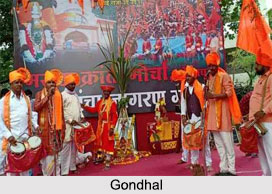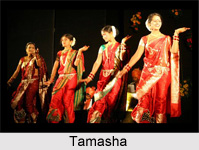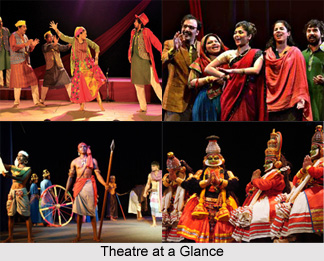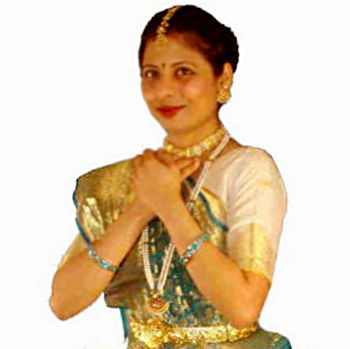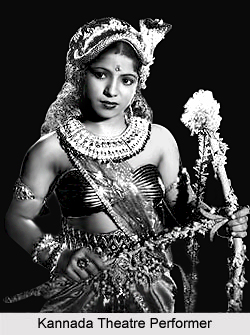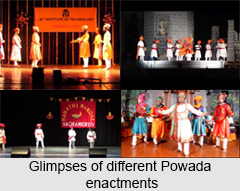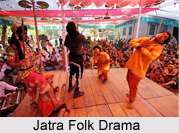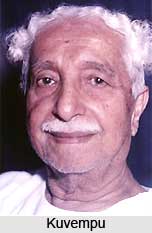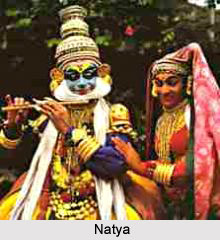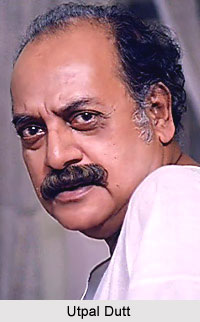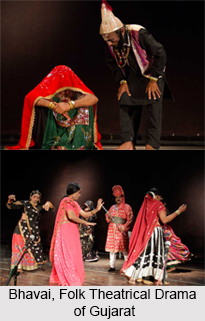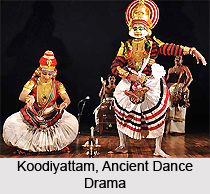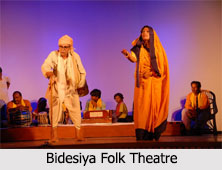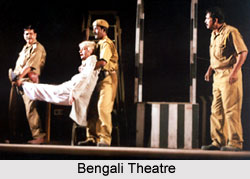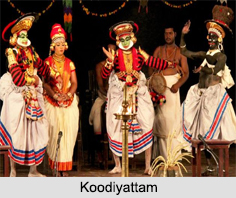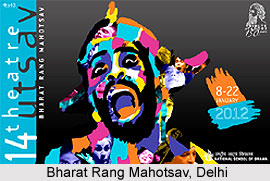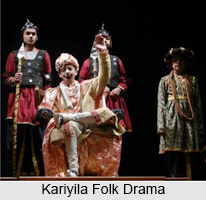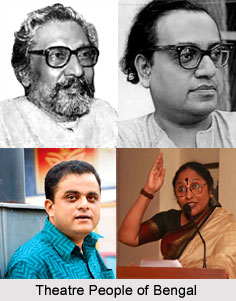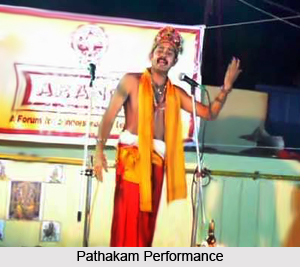 Pathakam is a type of performance in Malayalam theatre. It is a bi-lingual variety, semi-Sanskrit, and semi-Malayalam. In form and in nature, it is closely modelled on that variety of Kuttu which is called Prabandham Kuttu, and is probably connected with it in origin also. It consists of a dramatic exposition of any incident from the Puranas, the exposition being entirely in vernacular, while the verses for recital are in Sanskrit language. It entirely dispenses with any kind of stage equipment, and there are no conventions to be satisfied, except probably the presence of a lighted lamp to be kept in front of the actor. On account of its simplicity of staging, it is one of the most popular types of entertainment. As the term itself suggests, the actor or expositor must be very learned and must possess a witty tongue and shrewd powers of observation; these, in addition to a melodious voice constitute an ideal actor.
Pathakam is a type of performance in Malayalam theatre. It is a bi-lingual variety, semi-Sanskrit, and semi-Malayalam. In form and in nature, it is closely modelled on that variety of Kuttu which is called Prabandham Kuttu, and is probably connected with it in origin also. It consists of a dramatic exposition of any incident from the Puranas, the exposition being entirely in vernacular, while the verses for recital are in Sanskrit language. It entirely dispenses with any kind of stage equipment, and there are no conventions to be satisfied, except probably the presence of a lighted lamp to be kept in front of the actor. On account of its simplicity of staging, it is one of the most popular types of entertainment. As the term itself suggests, the actor or expositor must be very learned and must possess a witty tongue and shrewd powers of observation; these, in addition to a melodious voice constitute an ideal actor.
Costume of Pathakam
The costume of the actor is very simple, though quaint; he wears a head-dress which has some faint attempts at ornaments, though in the absence of this, any coloured piece of cloth round his head will quite suffice. His chest is generally bare, adorned with sandal paste, necklaces and other ornaments. There is nothing to mark of the stage from the audience but a lighted lamp, and there is no curtain.
Performance of Pathakam
When everything is ready, the actor comes, stands facing the audience and performs Mangala, the verse being mixed Sanskrit and Malayalam, in a voice that is scarcely audible. This is then followed by a long prose passage in which he sets forth the purposes of such dramatic expositions, the main object being religious education of the easiest and simplest type. This opening verse and the subsequent prose passage compare very favourably with the Nandi and Prarooana of the Sanskrit theatre stage. Once these are over, he begins in the local vernacular and describes the situation where the story begins.
Having thus well introduced the audience to the particular context, he recites the text which is in Sanskrit and proceeds to expound the same in vernacular with a wealth of illustrations, making adequate reference to the current social topics. There is little of acting, but appropriate gestures are utilised to make the narration as vivid as possible. The expositor enjoys freedom of speech to a certain extent, though for fear of losing his patronage he never uses it to the same extent as the Cakyar does. It will be seen from what has been said that the main aim of this variety of spectacular entertainment is to impart education leavened with wit and humour. This variety of entertainment is not far distinct from the variety of Kuttu called Prabandham Euttu.
Contribution of Pathakam in Literature
The prominence given to the vernacular and the freedom given to the performance, the place of acting and the actor are evident innovations introduced in the direction of simplification with a view to making Pathakam more and more popular. One ought to be grateful to the originators of Pathakam, for this has led to the creation of a number of works in Sanskrit language which are locally called Prabandhams.
In number they are over 30, and in size they may easily fill a volume of about 300 pages, while in intrinsic merit they occupy a very high place in literature. Here is a definite measure of Kerala contribution to Sanskrit Literature, but unfortunately it is as yet unknown. It is strange that not one of these has yet been published in Devanagari script. Again the need for an expository commentary to help the Pathakakkaran has also led to the creation of a school of literary criticism Malabar and it also adds a definite contribution of its own to literary criticism. Thus, it will be seen that Pathakam and Prabandham kuttu supplied not merely noble recreation to all alike, both the literate and illiterate but also enriched the Sanskrit Literature both by original works and valuable commentaries.
